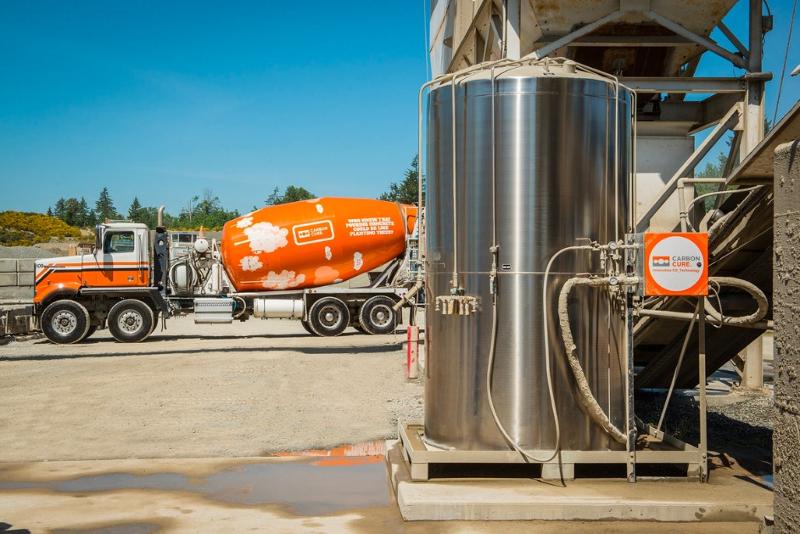In the world of construction, a groundbreaking idea is gaining traction: locking away carbon inside concrete. With over 4 billion metric tons of cement produced annually, the industry is responsible for a significant portion of global emissions. However, startups are now exploring ways to use CO2 in concrete production, from injecting it into the mix to growing synthetic aggregates. In this article, we will delve into the innovative technologies being developed and their potential to revolutionize the construction industry by reducing emissions and creating carbon-sequestering concrete.
CarbonCure: Transforming Concrete Production
Discover how CarbonCure's innovative technology injects CO2 into concrete mixes, reducing the need for cement while maintaining strength.
CarbonCure, a Canadian firm, has developed a groundbreaking process that injects CO2 into concrete mixes, transforming the gas into calcium carbonate. This not only reduces the carbon footprint of concrete production but also minimizes the amount of cement required, without compromising the strength of the material. By retrofitting their technology to 800 concrete plants globally, CarbonCure is revolutionizing the industry and paving the way for more sustainable construction practices.
With the demand for concrete increasing in both developed and developing economies, CarbonCure's technology offers a scalable solution for reducing emissions in the construction sector. By utilizing captured CO2, the company is not only providing a new use for the gas but also creating carbon-sequestering concrete that can help combat climate change.
Heirloom Technologies: Turning Limestone into a Carbon Sink
Explore how Heirloom Technologies uses limestone to capture CO2, which can be stored or injected into concrete, making buildings potential carbon sinks.
Heirloom Technologies has developed an innovative process that utilizes crushed limestone to capture CO2. By heating the limestone, CO2 is released and absorbed by the material, which can then be used to create carbon-sequestering concrete. This not only reduces emissions but also offers the potential for buildings to act as carbon sinks, storing CO2 for extended periods.
In a recent trial, Heirloom Technologies collected around 30kg of CO2, demonstrating the immense potential of their technology. By combining direct air capture with concrete production, the company aims to scale up their operations and contribute to the urgent need for carbon reduction in the construction industry.
CarbonBuilt: Revolutionizing Concrete Blocks
Learn how CarbonBuilt is transforming the production of concrete blocks by replacing high carbon Portland cement with low-cost alternatives and utilizing CO2 from direct air capture.
CarbonBuilt is focusing on revolutionizing the production of concrete blocks, which account for billions of metric tons of cement usage each year. By replacing high carbon Portland cement with low-cost alternatives derived from industrial byproducts, CarbonBuilt is significantly reducing emissions in the manufacturing process.
In addition, the company is exploring the use of direct air capture (DAC) to further reduce the need for burning fuel. By utilizing CO2 captured from the air, CarbonBuilt aims to create carbon-sequestering concrete blocks that contribute to the fight against climate change. With a carbon removal purchase agreement with Shopify, CarbonBuilt is paving the way for more sustainable and environmentally friendly construction materials.
Blue Planet Systems: Creating Sustainable Concrete with Synthetic Limestone
Discover how Blue Planet Systems combines CO2 captured from industrial emitters with recycled concrete to produce synthetic limestone aggregate, leading to more sustainable concrete production.
Blue Planet Systems has developed an innovative process that combines CO2 captured from heavy industrial emitters with recycled concrete to create synthetic limestone aggregate. This aggregate can then be used in concrete production, permanently locking away up to 440 kg of CO2 in every metric ton of aggregate produced.
By utilizing this sustainable aggregate, Blue Planet Systems is leading the way in creating more environmentally friendly concrete. The company's technology offers a viable solution for reducing emissions in the construction industry and creating a more sustainable built environment.
Conclusion
The construction industry is undergoing a transformative shift towards more sustainable practices, and the use of carbon-sequestering concrete is at the forefront of this change. Startups like CarbonCure, Heirloom Technologies, CarbonBuilt, and Blue Planet Systems are revolutionizing concrete production by utilizing CO2 in innovative ways, reducing emissions, and creating carbon-sequestering materials.
By injecting CO2 into concrete mixes, utilizing limestone to capture CO2, replacing high carbon cement with low-cost alternatives, and creating synthetic limestone aggregate, these companies are paving the way for a greener and more environmentally friendly construction sector. The potential for carbon-sequestering concrete to reduce emissions and store CO2 for extended periods offers a promising solution to combat climate change in the built environment.
FQA
How does carbon-sequestering concrete work?
Carbon-sequestering concrete utilizes innovative technologies to inject CO2 into concrete mixes or capture CO2 using materials like limestone. This process transforms the CO2 into a mineral form, reducing the need for cement and creating carbon-sequestering materials.
What are the benefits of carbon-sequestering concrete?
Carbon-sequestering concrete offers several benefits, including a significant reduction in emissions during production, the potential to store CO2 for extended periods, and the ability to create more sustainable and environmentally friendly construction materials.
Are these technologies scalable?
Yes, these technologies are scalable and have already been implemented in numerous concrete plants globally. With the demand for concrete in both developed and developing economies, these innovations offer a scalable solution for reducing emissions in the construction industry.
How can carbon-sequestering concrete contribute to climate change mitigation?
Carbon-sequestering concrete plays a crucial role in mitigating climate change by reducing emissions in the construction sector. By utilizing CO2 and creating carbon-sequestering materials, these technologies help to offset the carbon footprint of concrete production and contribute to global efforts to combat climate change.

